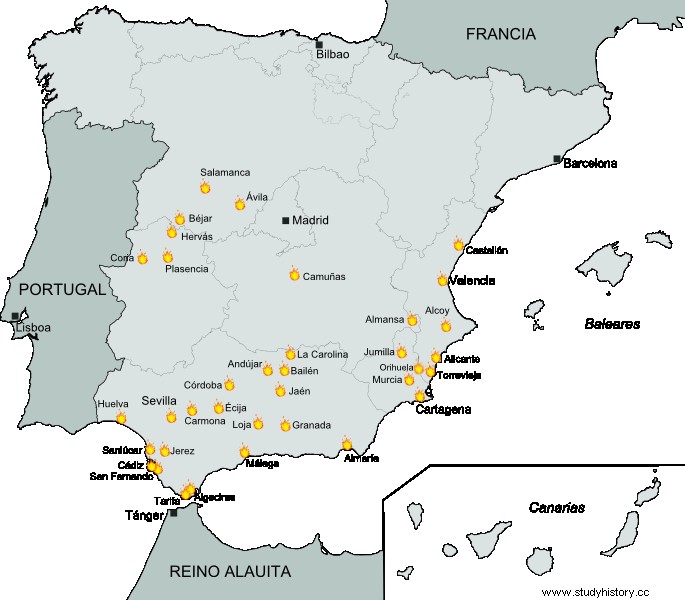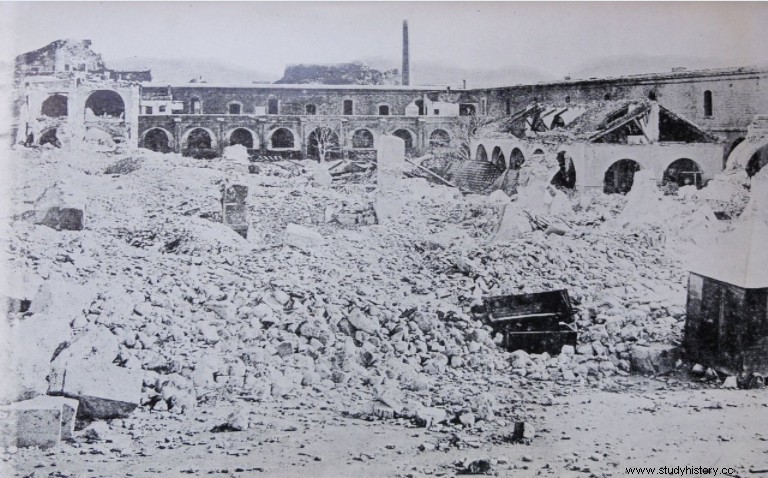
The context.
The cantonalist phenomenon falls within the framework of the First Spanish Republic, being one of the most extreme manifestations of that period since it involved an explosion of long-silent popular desires.
After the abdication of Amadeo I, the Cortes, united Congress and Senate in a call of dubious legality, proclaimed the Republic on February 11, 1873. 258 representatives voted in favor and 32 against, even though the majority of the deputies were monarchists. . Popular pressure was a key element in understanding the proclamation and subsequent acceleration of Republican political action.
The provisional government called elections to the Constituent Courts in May 1873, being widely won by the federal republicans. The new Cortes approved the establishment of the Federal Republic on June 10 with a very large majority. Thus began the debate on a new republican constitution.
The republican divisions – intransigent or exalted, centrist and moderate – brought Pi i Margall to the government and the constant popular pressure accelerated the cantonal revolution. On July 1, the intransigent deputies left the Cortes, considering the measures of the new government insufficient and not agreeing with the direction taken by the drafting of the new constitution. They immediately formed a Public Salvation Committee – note the conceptual affinity with the French Revolution – and demanded the formation of cantons throughout Spain.
The canton was a form of territorial organization in which a city and the territory under its influence –equivalent to a large extent to the municipal term– was constituted into an independent political unit that could later be united with other cantons to form a federal government:the Spanish Federation. The main divergence between the republicans affected the way of constituting this model of government; while the hardliners proposed to do it from the bottom up, the remaining federal republicans intended to approve the constitution first and then organize it from the top – government of the nation – down. In any case, the unity of Spain was never questioned, despite the fragmentation of the State that its model entailed.
The Murcian canton.
The epicenter of the uprising was Cartagena, but the uprising also spread to other towns in Murcia, including the capital:Torre Pacheco, San Pedro del Pinatar, Alcantarilla, Cieza, Caravaca, Cehegín, Molina de Segura, etc. However, there were always dissensions between Murcia, whose Junta was more moderate, and Cartagena, especially due to the economic exactions that the port city sought. The great exception was Lorca, which did not remain under the control of the rebels and served as a refuge for the centralist authorities and the ecclesiastical hierarchy that fled from Murcia.

The objective of this revolutionary movement was to create a political unit around the borders of the province:the Murcian canton. All the boards agreed on this, although the leading role was played, despite itself, by Cartagena.
On July 12 the cantonals take the castles that protect the city as well as the City Hall. A Revolutionary Junta for Public Salvation was immediately formed, which gave Antonio Gálvez – alias Antonete – the leadership of the revolutionary forces. With the help of General Juan Contreras they managed to seize the war fleet that was in the port and the Arsenal of the Navy. In this way, five frigates, two war steamers and a corvette remained in his power. With this strength and control of the nearby fortified castles, the Cartagena canton managed to maintain its independence until January 12, 1874.
Once power was established in Cartagena, the objective of the Junta was to expand the revolution. This was intended to achieve two purposes:reduce government pressure on the Murcian canton and avoid a possible siege, and obtain resources to keep the 9,000 men who made up the cantonal army under arms.
The land expeditions headed towards important cities –Hellín, Lorca, Orihuela– that had remained in the hands of the government. The navies covered a wide territory that extended from Valencia to Malaga, and this despite the fact that the government declared all the cantonal ships pirates, so some of them were captured by the British and German navies.

The decline of the cantonalist experience occurred after the defeat of Chinchilla (August 10, 1873) at the hands of General Martínez Campos. In addition to the human and material losses, the military failure left the road open to Murcia, which was occupied by the government army on the 13th of the same month. The Boards of the cantonal localities were dissolved and only the canton of Cartagena resisted.
The siege of the city, which was to last six months, was extremely violent. Some 30,000 artillery shells fell on the city in that time, destroying 80% of it and with episodes as dramatic as the explosion of the Artillery Park that caused the death of more than 500 civilians. This fact hastened the final surrender.

Political action and ideology.
The political measures imposed by the cantonal governments, although with slight local variations, had a clear progressive imprint:pardon of political prisoners, seizure of ecclesiastical property, eight-hour working day, suppression of monopolies, suppression of consumption, recognition of divorce , repeal of the death penalty, right to work, etc.
This progressive policy was accompanied by other gestures that strengthened it, such as the adoption of the red flag or the use of a political vocabulary inherited from the French Revolution. Likewise, the influence of the recent Paris Commune (March 18-May 28, 1871) was present in the revolutionary action of the canton.
The most clearly manifest ideology is federal republicanism. It is, however, a republicanism still imbued with an enlightened and messianic spirit:calls for civic virtues, political honesty, courage, enlightenment of the people, patriotism, etc. These ideas were far from seeking a revolutionary rupture since pragmatism, consideration for constitutional principles and respect for private property predominated in them
The links between the Murcian canton and the International are far from clear. Although the Cartagena Board incorporated some members of this organization, others, such as Murcia, opposed any relationship with it. In fact, the ideological distance is clear in crucial issues such as the treatment of property or social measures.
The social composition of the revolutionaries had an unquestionable petty-bourgeois character, with an important military component. This was the leading sector of the uprising that enjoyed, however, broad popular support based on the belief in the aforementioned republican myths.
Bibliography.
The canton of Cartagena (s.f.) In Wikipedia . Retrieved on December 16, 2016 from https://es.wikipedia.org/wiki/Cant%C3%B3n_de_Cartagena
Echenagusia, J. (2016). The First Republic. Reformism and social revolution . Madrid:RBA Books.
Gomez-Villamon, A. (2016). «The First Republic and the canton of Cartagena». Region of Murcia Digital. Retrieved from:http://www.regmurcia.com/servlet/s.Sl?sit=c,373,m,1915&r=ReP-25356-DETALLE_REPORTAJES
Puig, A. (1990). The Murcian canton . Murcia:Alfonso X el Sabio Academy.
Sender, R.J. (1997). Mr Witt in the canton . Madrid:Alianza Ed.
Victoria, D. (1996). The Murcian Canton . Journal of the cantonalist revolution. Annals of Contemporary History , 12. University of Murcia.
Vilar, J.B. (1983). The Democratic six-year term and the Murcian canton. Murcia:Alfonso X el Sabio Academy.
